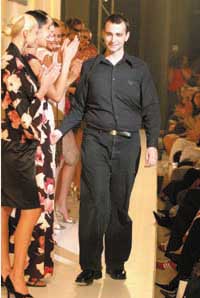|

The factory’s reputation for
exquisite workmanship has led to work in Belgium and Germany beading
bridal fabrics, facilitated by Scarvelli to ensure that they are
fairly paid for the work they do.
‘I can’t give them work 365 days of the year so
I supervise international clients they do work for. That keeps them
self-sufficient and I don’t take anything from them,’ he said.
‘They are like my family and I protect them as
much as I can. I have heard of so much abuse in India from the western
world and think it is disgusting.’
A co-op manager from the village runs the factory
and supervises the workers. Surplus money goes into a co-op fund
to be used for helping the extended families of the workers and
people in the village, from getting running water and pumps into
the village, electricity, helping people into housing, or aiding
those who require urgent hospital attention.
The factory also holds basic medical supplies
with 24-hour access.
Now fluent in Bangoli, Scarvelli travels to India
several times a year and, when I tracked him down, was planning
his 22nd visit.
What is amazing is that when he first set out
for Calcutta, he had no idea he was headed in the right direction—a
fact he only became aware of when a trip to Bombay revealed that
all the beadworkers spoke Bangoli.
Aside from the knowledge and techniques he has
taught the villagers, they have also taught him.
‘When we all get stuck we go to this guy in the
village who is in his 50s and a master who will work it out in 10
minutes,’ Scarvelli said.
The work the factory produces is so accurate that
often people cannot believe the work has been done by hand.
‘That is a compliment when I hear people say that,’
he said.
His masterpiece to date is his American Rose beaded
V-neck shift dress, a combination of nine colours, which was a showstopper
at MAFW ’04.
Scarvelli couldn’t buy the coloured beads he wanted
so he went back to the traditional method of blowing coloured dye
through each individual bead. It took four people two weeks to dye
the beads, and then another four weeks for Scarvelli and three assistants
to bead the fabric before it was ready to be cut.
However, it is a labour of love for Scarvelli,
who is driven by quality and ethics, and will always choose the
high moral ground over convenience.
He rescues rose quartz from sculptors’ scrap,
polishes up and drills holes in for beading.
‘[Mankind is] using so many of our natural resources
that we cannot reproduce. [At Gabriel Scarvelli] we use as much
as possible of any natural resource rather than throwing it away,’
he said.
Scarvelli favours natural fibres. Fabric scraps
from the workroom go to the local kindergarten to use for artwork,
while he worries about the mounds of polyester being created by
clothing manufacturers ‘because it is not a reusable plastic,’ and
‘the chemical wastage that comes off synthetic dyes is insane.
‘Under average conditions it takes synthetic fibre
300 years to break down. Even when it breaks down into particles
the soil is going to be chemically polluted. We have been producing
nylon since the 1940s and I’m just wondering where it all went to,’
Scarvelli said.
‘While we probably will never be able to eliminate
synthetics we can pull back on how much we use and make clothes
last better so they will last longer and be friendly to the environment.’
He admits that he uses nylon zippers (presently
he hasn’t another option); however, for the most part, the materials
he uses are natural and biodegradable. Only two dyes he uses contain
low-grade chem-icals; the other 38 are organic.
Giorgio Armani, who is growing organic cotton
crops in Peru, is an inspiration.
‘I really admire Armani for that. He has seen
our environment degraded from products that he has previously used,
and we are looking at doing the same thing in India,’ he said.
The people of his village recently offered to
gift Scarvelli some land so that he could build a house, as a way
of thanking him for all he has done for them. However, Scarvelli
has other ideas.
His goal is to help them set up an independent
organic cotton plantation for the village women to run, where they,
not him, financially benefit, and hopes the project will help them
become self-sufficient and raise their self-esteem in a culture
that doesn’t recognize women as equal.
He has already received interest for the cotton
from a buyer in the United Kingdom.
‘I think we should look after what we own and take
responsibility for all our actions and the effect they have on the
general picture, and the future of the world,’ Scarvelli said. •
Carolyn Enting is fashion editor of The
Dominion Post and TV One’s Good Morning, and is
a regular Lucire contributor.
|
 
  
|

